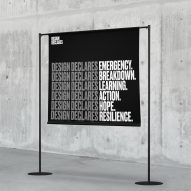The fear of being called out for “greenwashing” is paralysing designer-makers into doing nothing on the climate crisis. It’s time to let them make mistakes, writes Katie Treggiden.
“Carbon washing is the new greenwashing”; H&M called out for “greenwashing” in its Conscious fashion collection; “Greenwashing won’t wash”: all Dezeen headlines from the past few years. In fact, the last one was mine. And it’s important that we call out greenwashing – the practice of making false environmental claims in order to sell products, services or policies.
With 66 per cent of all shoppers – rising to 75 per cent among millennials – saying they consider sustainability when making a purchase, the reward is clear. But making products and services truly environmentally responsible takes time, money, and effort, and the road to get there is full of nuance, compromises and trade-offs – none of which makes for easy profits or simple advertising slogans, so companies lie, exaggerate and bend the truth to scoop those sales.
It’s important that we call out greenwashing
Advertising and sales are hardly known for being bastions of honesty, but greenwashing’s harm goes beyond simply misleading consumers into buying something they didn’t want. All the time, money, and effort invested into these practices is not being spent on actually becoming more sustainable, and companies are let off the hook. Meanwhile, the misled customers are not investing their money in the companies that are sincerely trying to do things better.
“Greenwashing perpetuates the status quo because it leads specifiers, end users, everyone in the chain to believe that they are doing better than they actually are from a sustainability point of view,” said founder of content marketing agency Hattrick, Malin Cunningham. “Equally, the businesses doing the greenwashing have no incentive to improve.”
However, all these “greenwashing” headlines are striking fear into the hearts of designers, makers, interior designers and architects who want to do the right thing, but haven’t quite got it all worked out yet. In a poll of my community of designer-makers, 100 per cent said that fear of getting it wrong had stalled progress on sustainability-driven projects.
Cancel culture and call-out culture are particularly prevalent on social media, which often lacks the nuance for proper discussions about environmentalism and yet, those are the very spaces in which small creative businesses are promoting their products and services.
All these “greenwashing” headlines are striking fear into the hearts of designers
The importance of failure in creativity is well documented. There’s the 5,126 failed prototypes James Dyson went through before finally cracking the technology behind his eponymous vacuum cleaner, the Thomas Edison quote: “I have not failed 700 times. I have succeeded in proving that those 700 ways will not work”, and the fact that Walt Disney’s first film company went bankrupt before he turned 21. But perhaps we’ve heard these kinds of stories so many times that we’ve forgotten what they mean.
In his book Atomic Habits, James Clear gives the example of a cohort of film photography students at the University of Florida. Their professor divided them into two groups. One would be graded solely on the quantity of photographs they produced – the more pictures, the higher the grade, no matter how good they were. The second group need only submit one photograph, but it would be judged on quality – to get an A, it needed to be near-perfect.
The result? The better photographs came from the first group, the group being judged on quantity alone. The moral of the story here is that in order for creative people to succeed, they need to be given permission to fail. Or put another way, holding them to a standard of near-perfection doesn’t create the conditions for success.
“The only way that we’re going to be able to tackle the huge challenges that humanity is facing is by trial and error,” said Cunningham. “Small independent businesses are very well placed to help find these solutions and it’s essential that they are allowed to experiment without being hung out to dry in the process.”
It’s important that we encourage imperfect progress, that we recognise honest intent
The difficulty is that the main difference between greenwashing and honest but imperfect progress is intent, and that can be difficult to discern. For designers and makers, Cunningham recommends transparency in communications.
“It is about having clarity around the environmental impact you’re making as a business and what your goals are – and then being transparent about where you are on your journey towards achieving those goals,” she said. “It means taking action first and communicating second.”
And what about those of us writing those headlines? It is, of course, crucial that journalists “speak truth to power” and continue to call out companies that are knowingly making exaggerated or outright false environmental claims.
But it’s also important that we encourage imperfect progress, that we recognise honest intent and that we ask the right questions to make sure we can tell the difference. In our coverage of sustainable design, we need to celebrate the journey as well as the destination.
We need to let designer-makers get sustainability wrong, so that they can get it right. All our futures depend on it.
Katie Treggiden is an author, journalist, podcaster and keynote speaker championing a circular approach to design. She is the founder and director of Making Design Circular, a membership community for designer-makers who want to become more sustainable.

